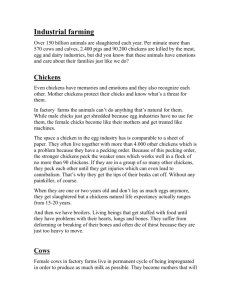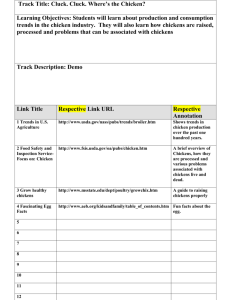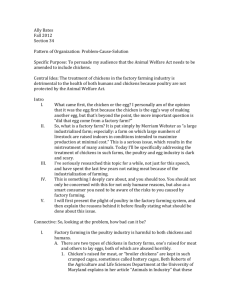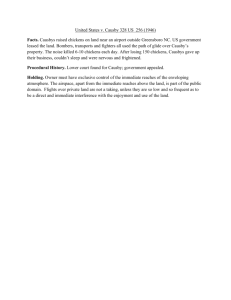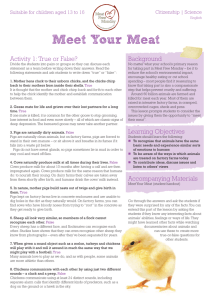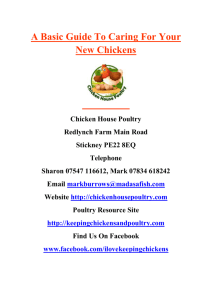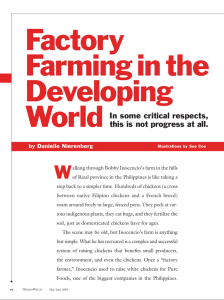Factory_Farming_-_Lorena_Mucke
advertisement
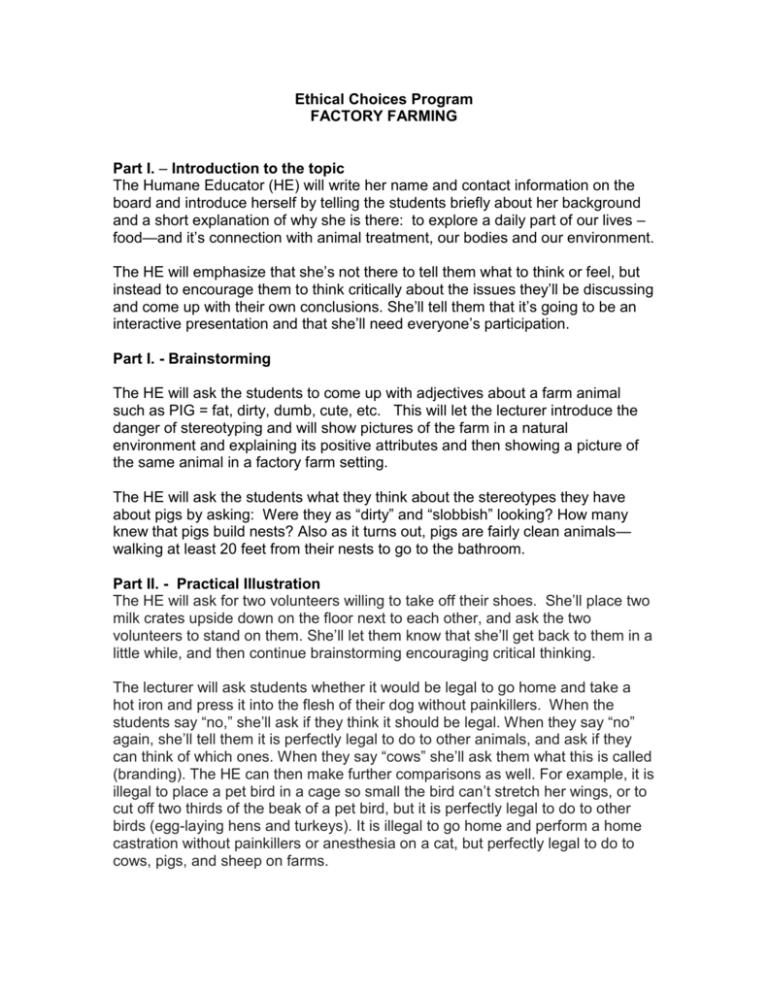
Ethical Choices Program FACTORY FARMING Part I. – Introduction to the topic The Humane Educator (HE) will write her name and contact information on the board and introduce herself by telling the students briefly about her background and a short explanation of why she is there: to explore a daily part of our lives – food—and it’s connection with animal treatment, our bodies and our environment. The HE will emphasize that she’s not there to tell them what to think or feel, but instead to encourage them to think critically about the issues they’ll be discussing and come up with their own conclusions. She’ll tell them that it’s going to be an interactive presentation and that she’ll need everyone’s participation. Part I. - Brainstorming The HE will ask the students to come up with adjectives about a farm animal such as PIG = fat, dirty, dumb, cute, etc. This will let the lecturer introduce the danger of stereotyping and will show pictures of the farm in a natural environment and explaining its positive attributes and then showing a picture of the same animal in a factory farm setting. The HE will ask the students what they think about the stereotypes they have about pigs by asking: Were they as “dirty” and “slobbish” looking? How many knew that pigs build nests? Also as it turns out, pigs are fairly clean animals— walking at least 20 feet from their nests to go to the bathroom. Part II. - Practical Illustration The HE will ask for two volunteers willing to take off their shoes. She’ll place two milk crates upside down on the floor next to each other, and ask the two volunteers to stand on them. She’ll let them know that she’ll get back to them in a little while, and then continue brainstorming encouraging critical thinking. The lecturer will ask students whether it would be legal to go home and take a hot iron and press it into the flesh of their dog without painkillers. When the students say “no,” she’ll ask if they think it should be legal. When they say “no” again, she’ll tell them it is perfectly legal to do to other animals, and ask if they can think of which ones. When they say “cows” she’ll ask them what this is called (branding). The HE can then make further comparisons as well. For example, it is illegal to place a pet bird in a cage so small the bird can’t stretch her wings, or to cut off two thirds of the beak of a pet bird, but it is perfectly legal to do to other birds (egg-laying hens and turkeys). It is illegal to go home and perform a home castration without painkillers or anesthesia on a cat, but perfectly legal to do to cows, pigs, and sheep on farms. 2 The HE will discuss whether these inconsistencies reflect a prejudice. Periodically the HE will check in with her two volunteers and find out how they are doing. They will likely tell her their feet hurt. The HE will continue by setting some restrictions for them (make “metal bars” that go up from the sides of the cage and bend knees and cramp down). She’ll tell them to pretend that there is a conveyor belt in front of them and that they can reach through the bars to eat the food on the belt. Also, that there are tubes of water on both sides of the cage that they can drink from. Lastly, if they need to go to the bathroom, they have to go in the cage and let their waste fall through the crate. Then the HE will briefly discuss the behavior of chickens in their natural environment vs. the ones in factory farms. The HE will ask the volunteers: how is everything up there? How would you feel if you had to stay in that position for a day? How about after a week? What about an entire year? How would you end up feeling about your cage mate? Would you still want to leave even if you had free rent, water, and food? Show us how you would exercise or stretch? Or sit down and sleep? The HE will add that after living in these cramped conditions for a long period of time, the hens often become aggressive and fight. She’ll ask the students to imagine being stuck in a little room with 10 strangers for nearly 17 months. The HE will explain that to deal with these aggressive behaviors, chickens are debeaked—having the tips of their sensitive beaks cut off with hot blades and without any painkillers. She’ll then ask: In such setting, what would happen if one got sick? (Students will probably say that the disease spreads to other chickens). The HE will agree and explain that under normal conditions natural sunlight and dust bathing helps chickens fight off parasites—but not in the dark and dirty conditions on factory farms. She’ll tell the students that problem is “solved” by feeding all the chickens antibiotics throughout there lives —whether sick or healthy, emphasizing that this not only is this harmful for the birds, but the drugs given to the chickens often carry over into the eggs, posing problems to human health. Then, the HE will “release” the volunteers thanking them for their participation and will ask her audience for a round of applause and continue by telling her class that the volunteers were representing egg-laying hens in modern factory farms, and explain that over 95% of eggs in the U.S. are produced in this way. The HE will then show slides of these facilities. She’ll allow the discussion to move toward explaining factory farming in general, and remind her audience that any of these cruelties would be illegal if done to pet dogs or cats (but not to dogs, cats, or other animals used in laboratories). The HE will show slidess of chickens 3 in battery cages, and ask them to notice ways in which the chickens look unhealthy or unhappy. Next the HE will ask the students if anyone knows what happens to male chicks born in such egg production settings. She’ll explain to them that since they do not lay eggs and it is not cost efficient to raise them for meat due to their size compared to broiler chickens, most of them are ground up for animal feed or are suffocated to death. The HE will explain one more reality about egg-laying hens in a factory farm setting: To speed up egg productions, forced molting is employed. Forced molting is a common method to prompt hens into a laying-cycle by depriving them of food for up to 2 weeks. Then, the HE will ask the students how they feel about the sad realities of factory farming and add that chickens aren’t the only animals that live and die in these conditions. Other animals such as cows, turkeys, and pigs are raised in factory farms. Part III- Visual Illustration The HE tells the students that she will show a short video “Meet your Meat” that contains some graphic images. She will give them the option to put their heads on the desk, cover their eyes or even step out of the classroom; however, she is going to emphasize that what the video will show is very important and that they might not have another opportunity to watch what actually goes on because the farming and food industry (McDonald’s, Burger King, etc) don’t want them to see it. Then the HE will show the video making sure the teacher stays in the rooms at all times. After the video the HE will thank the class for watching the video and tell them that she knows that a lot of it is very hard to watch. She’ll then ask: Any reactions people have? Or questions on what you saw? Was it what you expected it to be like? Part IV. - Teaching about Positive Choices A. The HE will tell the class what her typical breakfast is and then she’ll proceed to ask them: Why do I use soy milk instead of cow’s milk? Why don’t I eat eggs and bacon? She’ll discuss with the students how their dietary decisions can affect animals. She’ll mention that by becoming vegetarian, one can save up to 80 animals per year and thousands over one’s lifetime B. The HE will ask: What’s killing most people? She’ll ask students to name the primary causes of death in the U.S. (heart disease, cancer, strokes). She’ll ask them what causes these diseases (smoking causes 33% of cancer deaths, and contributes significantly to heart disease and strokes, however, it is estimated that approximately 30-50% of cancers can be 4 prevented through a healthy, low fat, vegetarian diet, while 80-90% of heart attacks can be prevented through such a diet). The HE will share some facts such as: • Vegetarians live several years longer than meat-eaters on average. • In countries where people eat a plant-based diet, heart disease, colon, prostate, and breast cancer (3 of the 4 most common cancers in the U.S.) are relatively rare. • In addition, a plant-based diet can prevent or cure: diabetes, kidney disease, osteoporosis, obesity, etc. C. Next, the HE will invite students to raise their hands and name any significant environmental problems that they can think of. It is likely that some of the following will be mentioned (in addition to other concerns): air & water pollution, nuclear & other toxic waste, resource depletion (including water, oil, minerals, etc.), garbage accumulation, habitat destruction, topsoil depletion, oil spills, endangered species, hole in the ozone, etc. She’ll write all their concerns on the board and then analyze each in terms of the effects animal agriculture has on each. This is an eye-opening exercise in which students realize how huge a role animal agribusiness plays in environmental problems. Part V. - Conclusions and Q&A The HE will tell the students that in spite of the cruel reality about factory farming, there is lot that can be done to change the current conditions that these animals are subjected to. She’ll emphasize that students must research on their own, ask questions and make decisions based on what they believe is right. The HE will invite students to ask questions and at the end she’ll thank them for being such a great group and let them know about the free literature she has available for them if anyone is interested. She’ll leave brochures and evaluation forms with the teacher as well.
